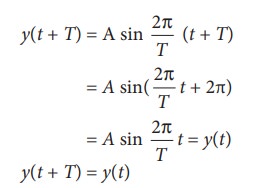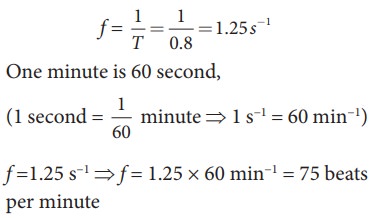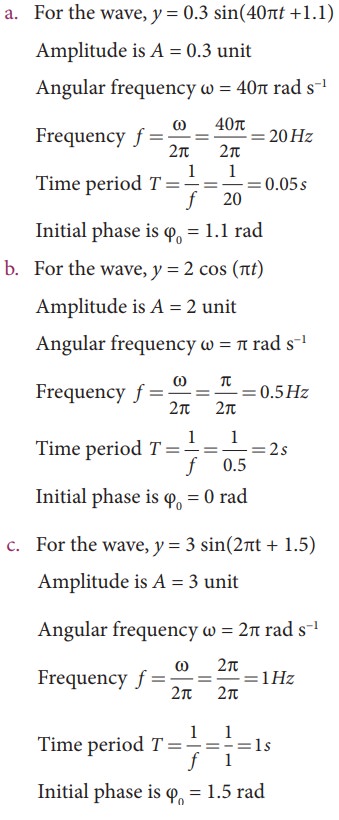Chapter: 11th Physics : UNIT 10 : Oscillations
Time period, frequency, phase, phase difference and epoch in SHM
Time period, frequency, phase, phase difference and epoch in SHM.
(i) Time period
The time period is defined as the time taken by a particle to complete one oscillation. It is usually denoted by T. For one complete revolution, the time taken is t = T, therefore

Then, the displacement of a particle executing simple harmonic motion can be written either as sine function or cosine function.

where T represents the time period. Suppose the time t is replaced by t + T, then the function

Thus, the function repeats after one time period.
This y(t) is an example of periodic function.
(ii) Frequency and angular frequency
The number of oscillations produced by the particle per second is called frequency. It is denoted by f. SI unit for frequency is s−1 or hertz (In symbol, Hz).
Mathematically, frequency is related to time period by

The number of cycles (or revolutions) per second is called angular frequency. It is usually denoted by the Greek small letter ‘omega’, ω. Comparing equation (10.11) and equation (10.12), angular frequency and frequency are related by

SI unit for angular frequency is rad s−1. (read it as radian per second)
(iii) Phase
The phase of a vibrating particle at any instant completely specifies the state of the particle.
It expresses the position and direction of motion of the particle at that instant with respect to its mean position (Figure 10.11).

where ωt + φ0 = φ is called the phase of the vibrating particle. At time t = 0s (initial time), the phase φ = φ0 is called epoch (initial phase) where φ0 is called the angle of epoch. Phase difference: Consider two particles executing simple harmonic motions. Their equations are y1 = A sin(ωt + φ1) and y2 = A sin(ωt + φ 2), then the phase difference ∆φ= (ωt + φ2) − (ωt + φ1) = φ2 −φ1.

EXAMPLE 10.5
A nurse measured the average heart beats of a patient and reported to the doctor in terms of time period as 0.8s. Express the heart beat of the patient in terms of number of beats measured per minute.
Solution
Let the number of heart beats measured be f. Since the time period is inversely proportional to the heart beat, then

EXAMPLE 10.6
Calculate the amplitude, angular frequency, frequency, time period and initial phase for the simple harmonic oscillation given below
a. y = 0.3 sin (40πt + 1.1)
b. y = 2 cos (πt)
c. y = 3 sin (2πt − 1.5)
Solution
Simple harmonic oscillation equation is y = A sin(ωt + φ0) or y =A cos(ωt + φ0)

EXAMPLE 10.7
Show that for a simple harmonic motion, the phase difference between
a. displacement and velocity is π/2 radian or 90°.
b. velocity and acceleration is π/2 radian or 90°.
c. displacement and acceleration is π radian or 180°.
Solution
a. The displacement of the particle executing simple harmonic motion
y = A sinωt
Velocity of the particle is
v = Aωcos ωt = Aωsin(ωt+ π /2)
The phase difference between displacement and velocity is π/2.
b. The velocity of the particle is
v = A ω cos ωt
Acceleration of the particle is
a = Aω2sinωt = Aω2cos(ωt+ π /2)
The phase difference between velocity and acceleration is π/2.
c. The displacement of the particle is y = A sinωt
Acceleration of the particle is
a = − A ω2 sin ωt = A ω2 sin(ωt + π)
The phase difference between displacement and acceleration is π.
Related Topics